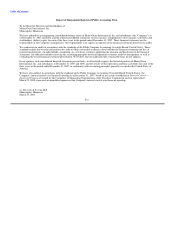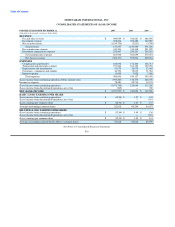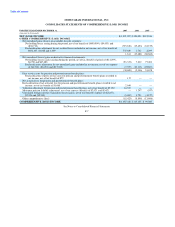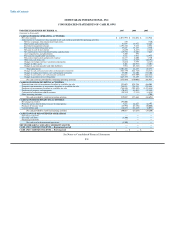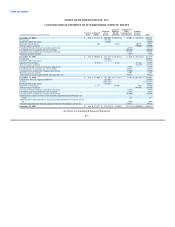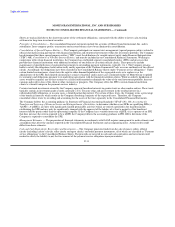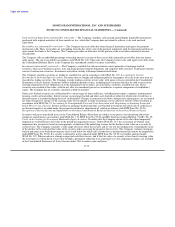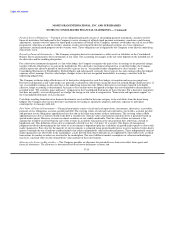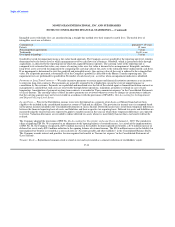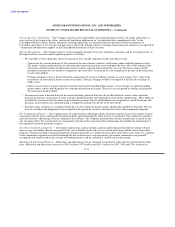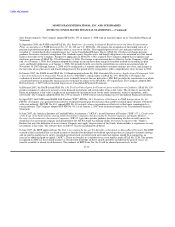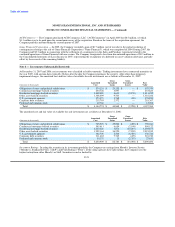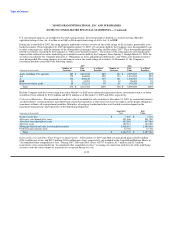MoneyGram 2007 Annual Report Download - page 88
Download and view the complete annual report
Please find page 88 of the 2007 MoneyGram annual report below. You can navigate through the pages in the report by either clicking on the pages listed below, or by using the keyword search tool below to find specific information within the annual report.
Table of Contents
MONEYGRAM INTERNATIONAL, INC. AND SUBSIDIARIES
NOTES TO CONSOLIDATED FINANCIAL STATEMENTS — (Continued)
Payment Service Obligations — Payment service obligations primarily consist of: outstanding payment instruments; amounts owed to
financial institutions for funds paid to the Company to cover clearings of official check payment instruments, remittances and clearing
adjustments; amounts owed to agents for funds paid to consumers on behalf of the Company; amounts owed under our sale of receivables
program for collections on sold receivables; amounts owed to investment brokers for purchased securities or reverse repurchase
agreements; and unclaimed property owed to various states. These obligations are recognized by the Company at the time the underlying
transactions occur.
Derivative Financial Instruments — The Company recognizes derivative instruments as either assets or liabilities on the Consolidated
Balance Sheets and measures those instruments at fair value. The accounting for changes in the fair value depends on the intended use of
the derivative and the resulting designation.
For a derivative instrument designated as a fair value hedge, the Company recognizes the gain or loss in earnings in the period of change,
together with the offsetting loss or gain on the hedged item. For a derivative instrument designated as a cash flow hedge, the Company
initially reports the effective portion of the derivative's gain or loss in "Accumulated other comprehensive (loss) income" in the
Consolidated Statements of Stockholders' (Deficit) Equity and subsequently reclassify the net gain or loss into earnings when the hedged
exposure affects earnings. For fair value hedges, changes in fair value are recognized immediately in earnings, consistent with the
underlying hedged item.
The Company evaluates hedge effectiveness of its derivatives designated as cash flow hedges at inception and on an on-going basis.
Derivatives designated as fair value hedges are generally evaluated for effectiveness using the short-cut method. Hedge ineffectiveness, if
any, is recorded in earnings on the same line as the underlying transaction risk. When a derivative is no longer expected to be highly
effective, hedge accounting is discontinued. Any gain or loss on derivatives designated as hedges that are terminated or discontinued is
recorded in the "Net securities gains and losses" component in the Consolidated Statements of (Loss) Income. For a derivative instrument
that does not qualify, or is not designated, as a hedge, the change in fair value is recognized in "Transaction and operations support" in
the Consolidated Statements of (Loss) Income.
Cash flows resulting from derivative financial instruments are classified in the same category as the cash flows from the items being
hedged. The Company does not use derivative instruments for trading or speculative purposes and limits exposure to individual
counterparties to manage credit risk.
Fair Value of Financial Instruments — Financial instruments consist of cash and cash equivalents, investments, derivatives, receivables,
payment service obligations, accounts payable and debt. The carrying values of cash and cash equivalents, receivables, accounts payable
and payment service obligations approximate fair value due to the short-term nature of these instruments. The carrying values of debt
approximate fair value as interest related to the debt is variable rate. The fair value of investments and derivatives is generally based on
quoted market prices. However, certain investment securities are not readily marketable. The fair value of these investments is the
amount that would be received from the sale of the security in an orderly transaction at the measurement date, other than a forced or
liquidation sale. This definition of fair value is commonly referred to as the "exit price" of a security. The degree of management
judgment involved in determining the fair value of an investment is dependent upon the availability of quoted market prices or observable
market parameters. Fair value for the majority of our investments is estimated using quoted market prices in active markets, broker-dealer
quotes or through the use of industry-standard models that utilize independently sourced market parameters. These independently sourced
market parameters are observable in the marketplace, can be derived from observable data or are supported by observable levels at which
transactions for similar securities are executed in the marketplace. The use of different market assumptions or valuation methodologies
may have a material effect on the estimated fair value amounts of these investments.
Allowance for Losses on Receivables — The Company provides an allowance for potential losses from receivables from agents and
financial institutions. The allowance is determined based on known delinquent accounts and
F-14


